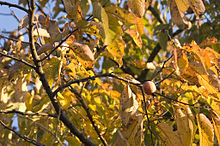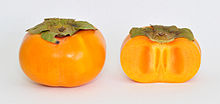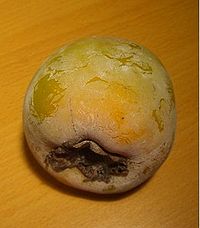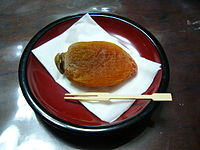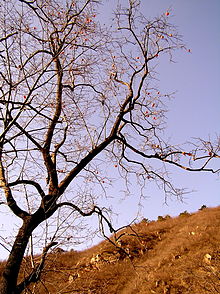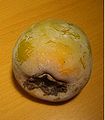- Persimmon
-
This article is about the edible fruit. For other uses, see Persimmon (disambiguation).
Persimmon 
American persimmon flower Scientific classification Kingdom: Plantae (unranked): Angiosperms (unranked): Eudicots (unranked): Asterids Order: Ericales Family: Ebenaceae Genus: Diospyros Species See text
A persimmon is the edible fruit of a number of species of trees in the genus Diospyros in the ebony wood family (Ebenaceae). The word Diospyros means "the fire of Zeus" in ancient Greek.[1] As a tree, it is a perennial plant. The word persimmon is derived from putchamin, pasiminan, or pessamin, from Powhatan, an Algonquian language of the eastern United States, meaning "a dry fruit".[2] Persimmons are generally light yellow-orange to dark red-orange in color, and depending on the species, vary in size from 1.5 to 9 cm (0.5 to 4 in) in diameter, and may be spherical, acorn-, or pumpkin-shaped.[3] The calyx often remains attached to the fruit after harvesting, but becomes easier to remove as it ripens. They are high in glucose, with a balanced protein profile, and possess various medicinal and chemical uses.
Like the tomato, it is not considered a "common berry", but is in fact a "true berry" by definition.
Contents
Select species
The shizi (柿子 in Chinese), also known as Japanese Persimmon or kaki (柿) (Diospyros kaki), is the most widely cultivated species. These are sweet, slightly tangy fruits with a soft to occasionally fibrous texture. This species, native to China, is deciduous, with broad, stiff leaves. Cultivation of the fruit extended first to other parts of east Asia, and was later introduced to California and southern Europe in the 1800s, to Brazil in the 1890s,[4] and numerous cultivars have been selected. It is edible in its crisp firm state, but has its best flavor when allowed to rest and soften slightly after harvest. The Japanese cultivar 'Hachiya' is widely grown. The fruit has a high tannin content which makes the immature fruit astringent and bitter. The tannin levels are reduced as the fruit matures. Persimmons like 'Hachiya' must be completely ripened before consumption. When ripe, this fruit comprises thick pulpy jelly encased in a waxy thin skinned shell.
"Sharon Fruit" (named originally after Sharon plain in Israel) is an Israeli-bred cultivar of the D. kaki fruit. The cultivar is called 'Triumph'.[5] As with all pollination-variant-astringent persimmons, the fruit are ripened off the tree by exposing them to carbon dioxide. The sharon fruit has no core, is seedless, particularly sweet, and can be eaten whole.[6] Eating the sharon fruit regularly is believed to reduce the risk of developing atherosclerosis heart attacks.[7]
Nanyo City, Yamagata, Japan. October 2005.
The Date-plum (Diospyros lotus) is native to southwest Asia and southeast Europe. It was known to the ancient Greeks as "the fruit of the gods", or often referred to as "nature's candy" i.e. Dios pyros (lit. "the fire of Zeus"), hence the scientific name of the genus. Its English name probably derives from Persian Khormaloo خرمالو literally "Date-Plum", referring to the taste of this fruit which is reminiscent of both plums and dates. This species is one candidate for the lotus mentioned in the Odyssey: it was so delicious that those who ate it forgot about returning home and wanted to stay and eat lotus with the lotus-eaters.[8]
The American Persimmon (Diospyros virginiana) is native to the eastern United States and is higher in nutrients like vitamin C and calcium than the Japanese Persimmon.[9] Its fruit is traditionally eaten in a special steamed pudding in the Midwest and sometimes its lumber is used as a substitute for ebony, e.g., in instruments.
The Black Persimmon or Black Sapote (Diospyros digyna) is native to Mexico. Its fruit has green skin and white flesh, which turns black when ripe.
The Mabolo or Velvet-apple (Diospyros discolor) is native to the Philippines. It is bright red when ripe. It is also native to China, where it is known as shizi. It is also known as Korean Mango.
There are many other species of Diospyros that are inedible to humans, and thus have little or no commercial value for their fruit.
Fruit
Commercially, there are generally two types of persimmon fruit: astringent and non-astringent.
The heart-shaped Hachiya is the most common variety of astringent persimmon. Astringent persimmons contain very high levels of soluble tannins and are unpalatable (or "furry" tasting) if eaten before softening. The astringency of tannins is removed through ripening by exposure to light over several days, wrapping the fruit in paper (probably because this increases the ethylene concentration of the surrounding air), and/or artificially with chemicals such as alcohol and carbon dioxide which change tannin into the insoluble form. This bletting process is sometimes jumpstarted by exposing the fruit to cold or frost which quickens cellular wall breakdown. These astringent persimmons can also be prepared for commercial purposes by drying. Tanenashi fruit will occasionally contain a seed or two, which can be planted and will yield a larger more vertical tree than when merely grafted onto the D. virginiana rootstock most commonly used in the U.S. Such seedling trees may produce fruit that bears more seeds, usually 6 to 8 per fruit, and the fruit itself may vary slightly from the parent tree. Seedlings are said to be more susceptible to root nematodes.
The non-astringent persimmon is squat like a tomato and is most commonly sold as fuyu. Non-astringent persimmons are not actually free of tannins as the term suggests, but rather are far less astringent before ripening, and lose more of their tannic quality sooner. Non-astringent persimmons may be consumed when still very firm, and remain edible when very soft.
There is a third type, less commonly available, the pollination-variant non-astringent persimmons. When fully pollinated, the flesh of these fruit is brown inside – known as goma in Japan – and the fruit can be eaten firm. These varieties are highly sought after and can be found at specialty markets or farmers markets only.[citation needed] Tsurunoko, sold as "Chocolate persimmon" for its dark brown flesh, Maru, sold as "Cinnamon persimmon" for its spicy flavor, and Hyakume, sold as "Brown sugar" are the three best known.
Before ripening, persimmons usually have a "chalky" taste or bitter taste.
- Astringent
- Hongsi (Korean: 홍시)- large, tall and shaped like an acorn
- 'Hachiya' (ja: 蜂屋), 'Kōshū hyakume' (ja: 甲州百目), 'Fuji' (ja: 富士)
- Tanenashi
- 'Hiratanenashi' (ja: 平核無)
- 'Tone wase' (ja: 刀根早生)
- 'Saijō' (ja: 西条)
- 'Dōjō hachiya' (ja: 堂上蜂屋)
- 'Gionbō'
- Sheng
- Ormond
Persimmons Nutritional value per 100 g (3.5 oz) Energy 293 kJ (70 kcal) Carbohydrates 18.59 g - Sugars 12.53 g - Dietary fiber 3.6 g Fat .19 g - saturated .02 g Protein .58 g Riboflavin (vit. B2) 2.5 mg (208%) Folate (vit. B9) 8 μg (2%) Vitamin C 7.5 mg (9%) Calcium 8 mg (1%) Iron .15 mg (1%) Sodium 1 mg (0%)
Diospyros kaki, raw
Percentages are relative to US recommendations for adults.
Source: USDA Nutrient DatabaseFruit production
The table below shows figures of persimmons for the world's top ten persimmon producing countries according to FAO statistics.
Production figures in tonnes per year[10] Country 1970 1990 1995 2000 2005 China 457,341 640,230 985,803 1,615,797 1,837,000 Korea 30,310 95,758 194,585 287,847 250,000 Japan 342,700 285,700 254,100 278,800 230,000 Brazil 21,659 46,712 51,685 63,300 150,000 Italy 59,600 68,770 61,300 42,450 51,332 Israel - 17,200 11,000 14,000 40,000 New Zealand - 972 1,600 1,200 1,300 Iran 25 925 1,000 1,000 1,000 Australia - 329 640 650 650 Mexico - 275 274 450 450 Culinary uses
 Peeled, flattened, and dried persimmons (shibing, 柿餅) in a Xi'an market
Peeled, flattened, and dried persimmons (shibing, 柿餅) in a Xi'an market
Persimmons are eaten fresh, dried, raw, or cooked. When eaten fresh, the skin is usually cut/peeled off and the fruit is often cut into quarters or eaten whole like an apple. One way to consume very ripe persimmons, which can have the texture of pudding, is to remove the top leaf with a paring knife and scoop out the flesh with a spoon. The flesh ranges from firm to mushy, and the texture is unique. The flesh is very sweet and when firm, possesses an apple-like crunch.[citation needed] American persimmons are completely inedible until they are fully ripe. In China, Korea, Japan, and Vietnam after harvesting, 'Hachiya' persimmons are prepared using traditional hand-drying techniques, outdoors for two to three weeks. The fruit is then further dried by exposure to heat over several days before being shipped to market. In Japan the dried fruit is called hoshigaki (干し柿), in China it is known as "shi-bing" (柿饼), in Korea it is known as gotgam (hangul: 곶감), and in Vietnam it is called hồng khô. It is eaten as a snack or dessert and used for other culinary purposes.
In Korea, dried persimmon fruits are used to make the traditional Korean spicy punch, sujeonggwa, while the matured, fermented fruit is used to make a persimmon vinegar called gamsikcho (감식초), which is alleged to have a variety of health benefits. The hoshigaki tradition traveled to California with Japanese American immigrants.
In Taiwan, fruits of astringent varieties are sealed in jars filled with lime water to get rid of bitterness. Slightly hardened in the process, they are sold under the name "crisp persimmon" (cuishi 脆柿) or "water persimmon" (shuishizi 水柿子). Preparation time is dependent upon temperature (5 to 7 days at 25–28 °C). In some areas of Manchuria and Korea, the dried leaves of the fruit are used for making tea. The Korean name for this tea is ghamnip cha (감잎차).
In the state of Indiana (USA), persimmons are harvested and used in a variety of dessert dishes most notably pies. It can be used in cookies, cakes, puddings, salads, curries [1] and as a topping for breakfast cereal. Persimmon pudding is a dessert using fresh persimmons. An annual persimmon festival, featuring a persimmon pudding contest, is held every September in Mitchell, Indiana. Persimmon pudding is a baked pudding that has the consistency of pumpkin pie but resembles a brownie and is almost always topped with whipped cream. Persimmons may be stored at room temperature (20 °C) where they will continue to ripen. In northern China, unripe persimmons are frozen outside during winter to speed up the ripening process.
Medical effects
The Sharon fruit was found to contain high levels of dietary fibre, phenolic compounds, potassium, magnesium, calcium, iron and manganese. They are also rich in vitamin C and beta carotene. Regular consumption of the fruit is believed to reduce the risk of atherosclerosis heart attacks. A separate research project showed that a diet rich in Sharon fruit persimmons improved lipid metabolism – the way the body copes with fat – in laboratory rats.[7]
The fruits of some persimmon varieties contain the tannins catechin and gallocatechin,[11] as well as the candidate anti-tumor compounds betulinic acid and shibuol.[citation needed]
Unripened persimmons
Unripened persimmons contain the soluble tannin shibuol, which, upon contact with a weak acid, polymerizes in the stomach and forms a gluey coagulum, a "foodball" or phytobezoar, that can affix with other stomach matter.[12] These phytobezoars are often very hard and almost woody in consistency. More than 85% of phytobezoars are caused by ingestion of unripened persimmons.[13] Persimmon bezoars (diospyrobezoars) often occur in epidemics in regions where the fruit is grown.[14][15][16] Diospyrobezoars should not be of concern when consuming moderate quantities of persimmons. One case in medical literature from 2004 revealed a 51-year old patient who had eaten a kilogram (2.2 pounds) of unpeeled persimmons each day for 40 years.[17][18] Cases have been rare and required surgical removal, but more recently chemical depolymerization by Coca-Cola has been used.[19]
Horses may develop a taste for the fruit growing on a tree in their pasture and overindulge also, making them quite ill. It is often advised that persimmons should not be eaten on an empty stomach.[20]
Wood
Though persimmon trees belong to the same genus as ebony trees, persimmon tree wood has a limited use in the manufacture of objects requiring hard wood. It is hard, but cracks easily and is somewhat difficult to process. Persimmon wood is used for paneling in traditional Korean and Japanese furniture.
In North America, the lightly colored, fine-grained wood of D. virginiana is used to manufacture billiard cues and textile shuttles. It is also used in the percussion field as the shaft of the Tim Genis Signature Timpani Mallet Collection, as well as several Vic Firth and Cooperman drumsticks. Persimmon wood was also heavily used in making the highest-quality heads of the golf clubs known as "woods" until the golf industry moved primarily to metal woods in the last years of the 20th century. In fact, the first metal woods made by TaylorMade, an early pioneer of that club type, were branded as "Pittsburgh Persimmons". Persimmon woods are still made, but in far lower numbers than in past decades. Over the last few decades persimmon wood has become popular among bow craftsmen, especially in the making of traditional longbows. Persimmon wood is used in making a small number of wooden flutes and eating utensils such as wooden spoons and cornbread knives (wooden knives that may cut through the bread without scarring the dish).
Like some other plants of the genus Diospyros, older persimmon heartwood is black or dark brown in color, in stark contrast to the sapwood and younger heartwood, which is pale in color.
Trees
The trees of all species have stiff, tumescent leaves, but the female of the D. virginiana can look less turgid than the male because the leaves droop when fruiting, perhaps because of the heavier nutrient requirements. They grow swiftly, and are immune to the usual delicacy of trees planted in unpredictable climates. Persimmons can tolerate and adapt to a wide range of climates. Persimmons are also notoriously resistant to diseases and pests. They are one of the last trees to leaf out in the spring, and do not flower until well after the leaves have formed, bypassing the threat of blossom loss to frosts. The fruit hangs on the branches long into the winter. Because they grow swiftly and colonize off their root systems, they are ideal for helping recover habitat. A 1–2 year old persimmon tree will be mature enough to bear fruit within 7–8 years. They hold their own against flooding riverbanks quite well and are listed in Stormwater Journal's list of water-holding trees.[21]
Apocryphal and traditional significance
- In Ozark folklore, the severity of the upcoming winter is said to be predictable by slicing a persimmon and observing the cutlery-shaped formation within it.[22] (This is "a myth with no bearing on weather forecasting").[22]
- In Vietnam, the fruit is a part of Mid-Autumn Festival offering.
- In traditional Chinese medicine the fruit is thought to regulate ch'i.
- The raw fruit is used to treat constipation and hemorrhoids, and to stop bleeding. Overconsumption can induce diarrhea, but the cooked fruit is used to treat diarrhea and dysentery; the opposing effects of the raw and cooked fruit are due to its osmotic effect in the raw fruit sugar (causing diarrhea), and the high tannin content of the cooked fruit helping with diarrhea.[citation needed]
- In philosophy, the painting of persimmons by Mu Qi (13th Century) exemplifies the progression from youth to age as a symbol of the progression from bitterness to sweetness. The persimmon when young is bitter and inedible, but as it ages it becomes sweet and beneficial to humankind. Thus, as we age, we overcome rigidity and prejudice and attain compassion and sweetness. Mu Qi's painting of Six Persimmons is considered a masterpiece.
- The folklore about the seed says that a spoon means snow while a fork is a milder winter and a knife is a cold biting winter.[23]
Gallery
-
Persimmon orchard northern Kansai region, Japan.
See also
References
- ^ Persimmons: Fruit of the Gods Retrieved on 2009-01-17.
- ^ Mish, Frederic C., Editor in Chief Webster's Ninth New Collegiate Dictionary Springfield, Massachuetts, U.S.A.:1984--Merriam-Webster Page 877
- ^ Carley Petersen and Annabelle Martin. "General Crop Information: Persimmon". University of Hawaii, Extension Entomology & UH-CTAHR Integrated Pest Management Program. http://www.extento.hawaii.edu/kbase/crop/crops/i_persim.htm. Retrieved 2007-01-15.
- ^ The persimmon was first introduced to the State of São Paulo, afterwards expanding across Brazil through Japanese immigration; State of São Paulo is still the greatest producer, with an area of 3,610 hectares dedicated to persimmon culture in 2003; cf. todafruta.com.br
- ^ The encyclopedia of fruit & nuts, By Jules Janick, Robert E. Paull, CABI, 2008, Page 327
- ^ The encyclopedia of fruit & nuts, By Jules Janick, Robert E. Paull, Page 327
- ^ a b Sharon fruit reduce heart attacks by James Chapman, Daily Mail
- ^ Homer. "The Odyssey". Project Gutenberg. p. 76. http://www.gutenberg.org/etext/1727. Retrieved 2007-10-13.
- ^ "Nutrition Facts Comparison Tool". Healthaliciousness.com. 2008. http://www.healthaliciousness.com/nutritionfacts/nutrition-comparison.php?o=9265&t=9263&h=&s=100&e=100&r=100. Retrieved 2008-12-03.
- ^ FAOSTAT
- ^ Nakatsubo, Fumiaki; Enokita, Murakami, Yonemori, Sugiura, Utsunomiya and Subhadrabandhu (October 2005). "Chemical structures of the condensed tannins in the fruits of Diospyros species". Journal of Wood Science (Jaoan: Springer Japan) 48 (5): 414–418. ISSN (Print) 1611-4663 (Online) 1435-0211 (Print) 1611-4663 (Online). http://www.springerlink.com/content/v02167564163632n/. Retrieved 2008-11-28.
- ^ Verstanding AG, Bauch K, Bloom R, Hadas I, Libson E; Small-bowel phytobezoars: detection with radiography, Radiology, 1989;172:705-707
- ^ Delia CW Phytobezoars (diospyrobezoars). A clinicopathologic correlation and review of six cases. Arch Surg. 1961 Apr; 82:579-83.
- ^ "Bezoars". Online Medical Dictionary. Merck. 2007. http://www.merck.com/mmpe/sec02/ch014/ch014b.html. Retrieved 2008-11-28.
- ^ The Merck Manuals Online Medical Libraries,Section: Gastrointestinal Disorders, Subject: Bezoars and Foreign Bodies, Topic: Bezoars
- ^ Merck Manual, Rahway, New Jersey, Sixteenth Edition, Gastrointestinal Disorders, Section 52, page 780
- ^ Persimmonpudding.com
- ^ Altinli, E.; Saribeyoglu, K.; Uras, C. (2004). "Laparoscopic extirpation of a large gastric diospyrobezoar". Case Rep Clin Pract Rev, 5: 503–505.
- ^ Hayashi, Kazuki; Ohara, Hirotaka; Naitoh, Itaru; Okumura, Fumihiro; Andoh, Tomoaki; Itoh, Takafumi; Nakazawa, Takahiro; Joh, Takashi (2008). "Persimmon bezoar successfully treated by oral intake of Coca-Cola: a case report". Cases Journal 1: 385. doi:10.1186/1757-1626-1-385.
- ^ Damrosch, Barbara (2004-4-11-25). "East Meets West in a Fall Fruit". The Washington Post. http://www.washingtonpost.com/wp-dyn/articles/A6965-2004Nov23.html. Retrieved 2008-12-02.
- ^ Stormh2o.com
- ^ a b Edwards, Ravae (2005-10-12). "From woolly worms to persimmons, people use a variety of methods to forecast the weather". News Tribune. http://www.newstribune.com/articles/2005/10/12/features/1009050040.txt. Retrieved 2008-12-02.[dead link]
- ^ Freshare.net, on the persimmon seed
Categories:- Diospyros
- Chinese ingredients
- Japanese ingredients
- Korean ingredients
- Vietnamese ingredients
- Algonquian loanwords
- Medicinal plants
- Berries
- Astringent
Wikimedia Foundation. 2010.

